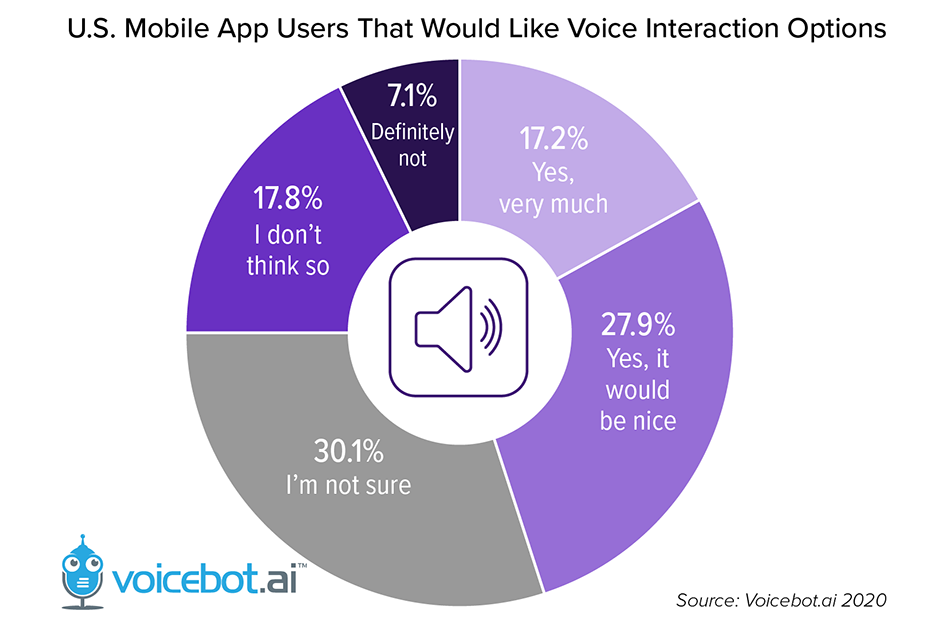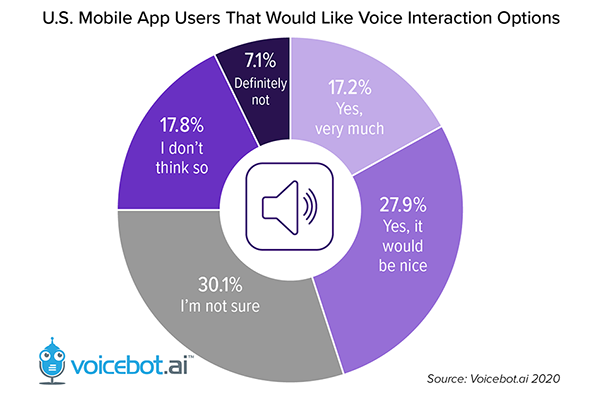National Consumer Survey Reveals that a lot of Consumers Want Voice Assistants in Mobile Apps
Voicebot’s biannual Smartphone Voice Assistant Consumer Adoption Report considered new questions in 2020 around consumer interest in and experience with voice interaction within mobile apps. A key finding is that consumers have strong interest in voice interactivity within mobile apps and more experience with these features than many people realize. Just over 45% of consumers said they would “very much” or that “it would be nice” to have voice assistant features within their favorite mobile apps. This figure compares to just 25% that said they were not interested.
Get Report
Voice for Navigation and Audio Entertainment Apps Show Most Consumer Interest
The survey also found that the highest consumer interest for voice capabilities was for mobile apps in the navigation and audio entertainment categories. Interestingly, these are also the categories where consumers had the most experience. In fact, over 70% of consumers that had used a voice assistant embedded within a mobile app had used it in a navigation app. The second most cited category was audio apps which includes streaming music and podcasts.
This is not a surprise as the navigation and audio content segments have been among the first to deploy voice control features in their apps. Examples include Waze, what3words, and Voice Navigation in the navigation category, along with Spotify and Pandora for audio entertainment.
Voicebot was able to report on consumer interest and experience to date for 17 different mobile app categories in two different charts. Our conclusion is that there is more consumer demand for voice interactive features than supply from mobile app publishers today. This suggests that mobile app publishers may be able to generate some user goodwill or cement higher loyalty by adding voice assistant features.
This is Not Siri or Google Assistant within a Mobile App
It is important to note that this question was not about adding a Siri Shortcut or Google Assistant App Action to a mobile app. Those approaches enable a user to employ Siri or Google Assistant to deep link into an app to a specific screen or to execute an action. However, once the user gets to that point, the Siri or Google Assistant session has ended. The user cannot use it more broadly to navigate the app through multiple turns or to access several features.
An embedded voice assistant provided by the app publisher can enable anything from voice search to more sophisticated app control. For example, Waze and what3words only offer voice-interactive search. You cannot navigate other app features using voice. By contrast, Bank of America and U.S. Bank have embedded assistants that enable you to access a wide number of features (hundreds in the case of U.S. Bank) using voice and even complete transactions.
Adding voice assistant features to mobile apps was once a very costly and complex undertaking. However, with the rise of white label solutions from Aiqudo, Alan AI, Microsoft, SoundHound, and Spokestack along with open-source tools such as Rasa, the cost, time, and complexity have dramatically decreased over the past two years.
The Smartphone Voice Assistant Consumer Adoption Report covers this topic in additional depth including the evolving landscape for voice in mobile apps. In addition, there are over 50 charts and 40 pages of analysis of the broader topic of voice on mobile devices including market share for Apple Siri, Google Assistant, Samsung Bixby, and Amazon Alexa, frequency of voice assistant use on smartphones, and a detailed breakdown of users by age, income, and gender. You can access an executive summary of the report at no cost using the button below.
Read Report
Follow @bretkinsella Follow @voicebotai
Voice Assistant Use on Smartphones Rise, Siri Maintains Top Spot for Total Users in the U.S.
Nearly 90 Million U.S. Adults Have Smart Speakers, Adoption Now Exceeds One-Third of Consumers









